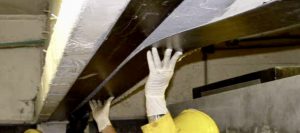Structural Strengthening & Repair
FRP: Structural repair describes the process of reconstructing a facility or its structural elements. Structural strengthening is an upgrade of a building’s structural system designed to improve performance under existing loads or to increase the strength of the existing structural components to carry additional loads. Fiber reinforced polymer (FRP) systems are paper-thin fabric sheets bonded to concrete members with epoxy adhesive that significantly increase load-carrying capacity. An epoxy adhesive is applied to the prepared surface, the FRP fabric is laid into the epoxy and into the epoxy and then a second layer of the epoxy adhesive is applied on top. After curing, the FRP composite will add considerable capacity to the element despite the fact that it is a very thin laminate because the carbon FRP has a tensile strength up to 10 times that of steel. IPCC has successfully applied projects under Structural Repair and Structural Strengthening requirements.
CFRP: Carbon fiber reinforced polymers are applied the same as above but because the carbon FRP has a tensile strength up to 10 times of that steel the structural increase is exponential.
Crack Injection: Concrete Crack Injection is the preferred repair method for both cracks in horizontal concrete foundations, and vertical concrete surfaces. It also is used to eliminate moisture intrusion in cracks left from other foundation repairs.
